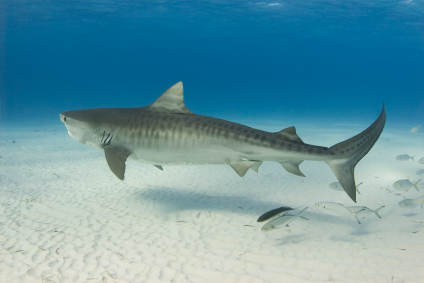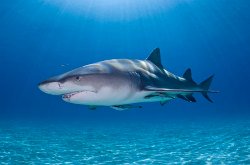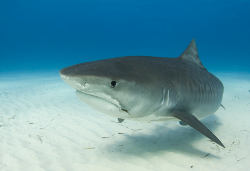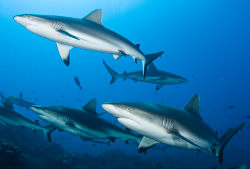Carcharhinidae
The Requiem Sharks
Carcharhinidae, or the Requiem shark family, belongs to the order Carcharhiniformes and has some very interesting members, including the only freshwater species.

This is one of the largest families with 54 species in 12 genera.
|
|
Requiem sharks are found worldwide in tropical and temperate waters. The Bull Shark and the River Sharks can also be found in rivers inland.
Carcharhinidae Characteristics:
- General Body Shape - Spindle shaped bodies being wider in the middle and tapering towards the nose and tail. Most members of this family are medium to large in size, usually ranging from about 1 - 3m, though some smaller members are less than a metre in length and larger ones may be over 7m.
- Eyes - Eyes are round and have an internal nictitating membrane for protection.
- Teeth - The sharks have arched mouths with blade-like teeth. The teeth of the upper jaw are often broader then those in the lower jaw.
- Gills - They have five gill slits and spiracles are often not present. Some of these sharks breathe by the ram-ventilation method and, therefore, need to keep moving in the water.
- Fins - The pectoral fins are situated behind the gill slits. The first dorsal fin is bigger than the second and usually set well ahead of the pelvic fins. The upper lobe of the caudal fin is bigger than the lower. One anal fin present.
Requiem sharks are active hunters and eat a wide range of prey. Some are opportunistic scavengers.
Return to World of Sharks from Carcharhinidae

Lemon Shark

Tiger Shark

Grey Reef Sharks
Recent Articles
-
Thresher Sharks
Aug 27, 14 10:51 AM
Thresher sharks are unmistakable with that huge upper lobe on the caudal fin. Let's find out more about them. -
Sharkwater
Aug 14, 14 12:42 PM
Sharkwater is a documentary by Rob Stewart highlighting the plight of the sharks in our oceans. -
Natural Cleaners
Aug 13, 14 08:57 AM
Natural cleaners and homemade skincare products are not only better for the environment, they're better for you and your family.
